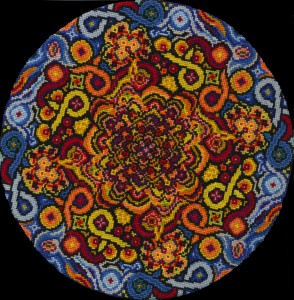“Non-thinking repetition of mechanical forms allows one to concentrate simply on being without the distraction of having to make decisions, artistic or otherwise.” (Leonard Koren, Wabi Sabi for Artists, Designers, Poets & Philosophers , p.35)
Those in the artistic community who derogate certain kinds of craft sometimes call it mindless repetition. There is, though, an important difference between mindless repetition and, as Koren says, “non-thinking repetition.”
If one values the practice of craft for its qualities as a meditative activity, as I do, then to call it mindless is simply incorrect, for the essence of any truly meditative act is mindfulness. Certainly this must be what Koren means. Non-thinking repetition is mindful repetition. The meditative crafter seeks to be fully present in the moment by transcending the distraction posed by thoughts, detaching from them so as not to be drawn away from the present reality by following them.
Mindlessness, on the other hand, is not just thoughtlessness, but unconsciousness, as though one practices a craft in one’s sleep. It is possible, I suppose, for crafters to practice mindlessly, producing in a sort of mental blackout. But crafters I know who are passionate about their mediums describe to me a state of total engagement, not trance-like disengagement.
If we agree that all thought is the product of ego, then the goal of meditative, or mindful craft is ego-lessness. And this I think is the reason western art insists on relegating c raft to the fringes of the artistic community. Truly, western art seems too often to be all about ego.
raft to the fringes of the artistic community. Truly, western art seems too often to be all about ego.
So what happens when one practices non-thinking craft? What role is consciousness playing in the act? Is the mind really, as Koren suggests, making decisions?
Being fully present means opening one’s consciousness to the experience of what is arising. When I cross stitch, I work on blank aida cloth with as few preconceptions as possible. In the beginning years, I tried to work with motifs or realize complex patterns that had suggested themselves to me in my dreams or during sitting meditation. Over time I learned to free myself from such preconceptions and now stitch with as little intent as I am capable of. The simple x pattern is the ritual form that initiates the meditative state. As each stich completes itself, options present themselves: up/down, left/right on the cloth. The needle is called to one of them and repeats the ritual pattern. Immediately form emerges: lines, squares, curves, angles. If one stitches with colored thread, as many do, colors call for other colors, color and form begin to interact, complex patterns arise. The mindful worker responds by plying the needle as the emerging image directs it. The reward is the realization that the mind is a co-equal participant in the arising.
So what is really happening? The only decision the crafter makes is whether to be the emerging image or detach from it in order to try to control it. The mind practicing the craft collaborates with the medium and the potential in the emptiness of the blank canvas to bring the image forth. The mind is a midwife of sorts, a useful, even necessary facilitator of the process of becoming.
The ego’s only role is to ply the needle.
One reply on “mindfulness and craft”
What magnificent outcomes emerge.